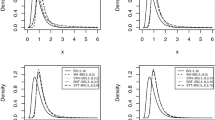Abstract
A new generalized Birnbaum–Saunders distribution (Type-I GBS) was presented in Owen (IEEE Trans Reliab 55:475–479, 2006) to model a lifetime of a product under cyclic stresses by using a long memory process on the crack extensions. This highly flexible model includes the original BS distribution as a special case and can be widely applied in fatigue studies. In this article, we present the relevant properties, parameter estimation, and hypothesis testing for the distribution. We explore the traditional maximum likelihood estimation approach, and propose a new inference method for the GBS-I distribution. An extensive simulation study is carried out to assess performance of the methods, and a real data is analyzed where it is shown that the GBS-I model with the proposed method provides an efficient estimation and achieves a better fit than the classic likelihood-based procedure.





Similar content being viewed by others
Change history
05 June 2018
The funding information was missing in the original version of this article. The correct funding information is given.
References
Balakrishnan N, Leiva V, Sanhueza A, Cabrera E (2009) Mixture inverse Gaussian distribution and its transformations, moments and applications. Statistics 43:91–104
Birnbaum ZW, Saunders SC (1969) A new family of life distributions. J Appl Probab 6:319–327
Desmond AF (1986) On the relationship between two fatigue-life models. IEEE Trans Reliab 35:167–169
Díaz-García JA, Domínguez-Molina JR (2006) Some generalizations of Birnbaum-Saunders and sinh-normal distributions. Int Math Forum 1:1709–1727
Díaz-García JA, Leiva V (2005) A new family of life distributions based on elliptically contoured distributions. J Stat Plan Inference 128:445–457 (Erratum: J Stat Plan Inference 137:512–1513)
Leiva V, Riquelme M, Balakrishnan N, Sanhueza A (2008) Lifetime analysis based on the generalized Birnbaum-Saunders distribution. Comput Stat Data Anal 52:2079–2097
Leiva V, Vilca-Labra F, Balakrishnan N, Sanhueza A (2010) A skewed sinh-normal distribution and its properties and application to air pollution. Commun Stat Theory Methods 39:426–443
Meeker WQ, Escobar LA (1998) Statistical methods for reliability data. Wiley, New York
Owen WJ (2006) A new three-parameter extension to the Birnbaum-Saunders distribution. IEEE Trans Reliab 55:475–479
Owen WJ, Ng HKT (2015) Revisit of relationships and models for the Birnbaum-Saunders and inverse-Gaussian distribution. J Stat Distrib Appl 2:11. https://doi.org/10.1186/s40488-015-0034-8
Sanhueza A, Leiva V, Balakrishnan N (2008) The generalized Birnbaum-Saunders and its theory, methodology, and application. Commun Stat Theory Methods 37:645–670
Terrell GR (2002) The gradient statistic. Comput Sci Stat 34:206–215
Wang L, Dai Z, Yang F, Zheng X (1995) Research and comments of mathematical analysis problems. Science Press, Beijing, pp 155–156
Acknowledgements
The authors are grateful to the Editor, the Associate Editor, and the referees for their constructive comments and suggestions for improving this paper.
Author information
Authors and Affiliations
Corresponding author
Appendices
Appendix A: Fisher Information for the GBS-I
From the expressions in (7)–(9), and the following facts
the second partial derivatives are given by
So the Fisher’s information matrix is
where the elements are the expectations of the second partial derivatives in (30)–(33). Unfortunately, due to the complexity, there are no theoretical forms for the elements except \(u_{\alpha \alpha } = -E(\partial ^2 \ell /\partial \alpha ^2) = 2n/\alpha ^2\) by using the fact that \(Z=\varepsilon (T)/\alpha \sim N(0,1)\). The observed \(I(\hat{\kappa },\hat{\alpha },\hat{\beta })\) is evaluated at MLEs \(\hat{\kappa },\hat{\alpha },\hat{\beta }\).
Appendix B: Proof of Uniqueness of \(\hat{\kappa }_N\)
First we show the function in the Eq. (20)
is decreasing for \(\kappa > 0\). Since
Let \(g(\kappa )\) be the numerate function of \(G'(\kappa )\). By switching the index of i and j in the summation, we have
Since \((T_i-T_j)\) and \((\log T_i - \log T_j)\) have the same sign for any values of \(T_i\) and \(T_j\), it leads to \((T_i-T_j)(\log T_i - \log T_j) > 0\). Hence the function \(g(\kappa ) < 0\), and so \(G'(\kappa ) < 0\). Additionally, \(\lim _{\kappa \rightarrow 0} G(\kappa ) = \sum _{i=1}^n T_i/n\) and \(\lim _{\kappa \rightarrow 1} G(\kappa ) = n(\sum _{i=1}^n T_i^{-1})^{-1}\). It is known that \(n(\sum _{i=1}^n T_i^{-1})^{-1} \le (\prod _{i=1}^n T_i)^{1/n} \le (\sum _{i=1}^n T_i)/n\) for any positive values of \(T_i's\), and we conclude that there is a unique solution of \(\hat{\kappa }_N\) in Eq. (20). Figure 5 shows the plot of \(G(\kappa )\) for a sample data \(T_1,\ldots ,T_n\).
Rights and permissions
About this article
Cite this article
Wang, R., Sha, N. & Xu, X. Statistical Inference for Type-I Generalized Birnbaum–Saunders Distribution. J Indian Soc Probab Stat 19, 469–487 (2018). https://doi.org/10.1007/s41096-018-0044-1
Accepted:
Published:
Issue Date:
DOI: https://doi.org/10.1007/s41096-018-0044-1




